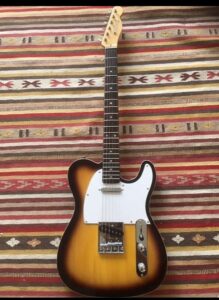What is all that stuff on your desk I have been asked.

My reply. It all has a place and a purpose. If not for others, for me.
Let us go in then, an inventory of sorts.
One screen good, two screens better. I would gladly have more given the opportunity. Twice the space and sprawl. I have been jealously stalking a mammoth curved Samsung screen for no good reason to be honest. But I could work approaching not 24/7 (god forbid) but 360 degrees. For the eagle eyed and there aren’t many these times, the screen desktop on the right is a photograph of a sensational sunset. A large print of the same shot I took reposes on the living room wall.
How do you increase your desk area has no one asked ever. But if we only answered questions where would we be. So I answer regardless. Opinion. Fact. Theory. Whatever, it works for me. I haven’t actually measured the extra space provided by my mezzanine desk innovation but the difference is noticeable.
By repurposing a couple of mesh in trays & magazine racks I was very pleased with myself. Miscellaneous usb hubs, chargers, ink jars and diverse objects can stay on the desk, close at hand but out of sight. What of your in-tray you may ask. Well, all I ever really did was let it pile up until crisis point whereupon I threw it all in the bin. Now I just throw it in the bin straight away. Out with the inbox and into the outbox. I have places I stuff things. That works for me but I can’t always find the things stuffed.
There are three lights on my desk, two useful and one ornamental. One of the useful ones is in use here, the ornamental one is on but of no real use, while the third and therefore second useful one is off, and out of sight. But it is there even though it is off and emitting no light. All IKEA. Airplants I have several. One in the 1/3 pint milk bottle was bought in a posh garden centre where they sell ludicrously expensive garden pottery, statues, gazebi and other follies. (I like gazebi rather than gazeboes). The other airplant lives in a reused Glendalough gin bottle, that I constructed myself, although sadly I did not deconstruct the gin myself. The green glass beads come from an ornament in our home in Omagh. Typical Christina nic nacs.
There in their small green case, Rosary beads given to me when we met Pope Francis the first time in Rome. Also there is a sleeping St Joseph, a strong man of silence (no not me). I let him sleep on anything that is bothering me. The Pope asked me to pray for him. I do.
Phone/iPad/tablet stands are there – for utility rather than ornament. Some people want to look at me when they talk to me. Why for the love of God I do not know. I find it difficult to look at myself betimes and used to tell myself that when I toiled at that University. ‘Look at the shape of you I would chide.’ Then I would look at the state of some of the Professors I had to deal with and was reassured.
Capo. This is a rather expensive Thalia capo I splashed out on during lockdown. A clunky bit of indulgent guitar bling and typically American. Well-crafted and substantial, but the best capos I have are Shubb. I have several depending on the instrument of torture on any given day.
Desk life, roaming wild. Wooden hippo, I Giorni. Fantastical Glass animals from Rome.
Fountain pens, Parker. Black, blue and roasted red ink. I only really use these pens or a pencil in my work notebooks. As the channel through which my thoughts make it into the real world, or at least the world I inhabit, it is only fair that the instrument should be elegant and the notebook deserves no less. Sometimes a pen can be blocked, scratchy, devoid of ink, or can overflow and flood a page. Just like its owner.
Item. Mac keyboard with annoying sticky a key. I had it replaced but it’s still not a hundred per cent.
Notebooks, one for work, I have a couple of shelves full of material I should revisit. Another for music, chords, theory, progressions, words, songs made suddenly clear. Also a journal for writing therapy. Therein I document the passage of grief, anxieties, insecurities and observations. I lament and keen and weep for things and people passed. Writing something down is therapeutic. Even pointless pieces like this piece have purpose. Peace. Settles an unquiet mind. I recommend it. If people like it, well that’s their choice.
That book there about the early church in Ireland I will read with interest. I came upon it looking for another. Ireland’s landscape is punctuated with monastic dwellings, holy wells, a landscape of faith rich in story and alive.
There I see an LP coffee coaster Cáit got me for Christmas a while back. Also there my ruler. Most people have rulers that go to 30cm but mine goes to…31cm. One centimetre can make all the difference. The man smiling benignly from the photo and observing every move I make is my dad. Younger when he died.
Than I am now. The cross on the wall is a penal cross made from turf by the sadly defunct Owen Crafts. We brought one to Peru on our honeymoon and presented it to a family we stayed with on Isla Taquile. I remember the nodding, smiling total lack of understanding in the Quechua speaking woman and her husband as I talked about Lough Derg. I don’t imagine they ever made it over.
Thonder a Tibetan singing bowl. It’s deep tone is strangely calm and healing. It amused my mother greatly.
The desk itself cost 18 quid from IKEA when I was getting myself started. It’s wobbly, chipped and cheap. I should consider another but it has served its purpose well.
And what of these trinkets. Essentially they mean nothing and when I’m done could all be swept into a bin bag and dumped. But they are familiar, calm, reassuring. For me.
And what of this piece? An exercise in writing about nothing that I set myself today as part of trying. Job done. Nothing ventured.







